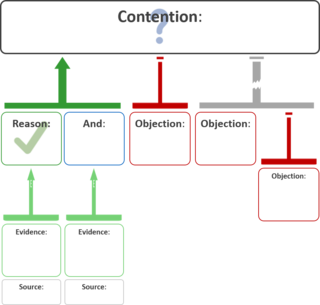Ad hominem, short for argumentum ad hominem, is a term is applied to several different types of arguments, most of which are fallacious. Typically it refers to a fallacious argumentative strategy whereby genuine discussion of the topic at hand is avoided by instead attacking the character, motive, or other attribute of the person making the argument, or persons associated with the argument, rather than attacking the substance of the argument itself. The most common form of this fallacy is "A makes a claim a, B asserts that A holds a property that is unwelcome, and hence B concludes that argument a is wrong".
A cosmological argument, in natural theology and natural philosophy, is an argument in which the existence of God is inferred from alleged facts concerning causation, explanation, change, motion, contingency, dependency, or finitude with respect to the universe or some totality of objects. It is traditionally known as an argument from universal causation, an argument from first cause, or the causal argument.. Whichever term is employed, there are three basic variants of the argument, each with subtle yet important distinctions: the arguments from in causa (causality), in esse (essentiality), and in fieri (becoming).

Omniscience is the capacity to know everything. In monotheistic religions, such as Sikhism and the Abrahamic religions, this is an attribute of God. In Jainism, omniscience is an attribute that any individual can eventually attain. In Buddhism, there are differing beliefs about omniscience among different schools.

Reason is the capacity of consciously making sense of things, applying logic, and adapting or justifying practices, institutions, and beliefs based on new or existing information. It is closely associated with such characteristically human activities as philosophy, science, language, mathematics, and art, and is normally considered to be a distinguishing ability possessed by humans. Reason, or an aspect of it, is sometimes referred to as rationality.

In classical rhetoric and logic, begging the question is an informal fallacy that occurs when an argument's premises assume the truth of the conclusion, instead of supporting it. It is a type of circular reasoning: an argument that requires that the desired conclusion be true. This often occurs in an indirect way such that the fallacy's presence is hidden, or at least not easily apparent.
A syllogism is a kind of logical argument that applies deductive reasoning to arrive at a conclusion based on two or more propositions that are asserted or assumed to be true.
A fallacy is the use of invalid or otherwise faulty reasoning, or "wrong moves" in the construction of an argument. A fallacious argument may be deceptive by appearing to be better than it really is. Some fallacies are committed intentionally to manipulate or persuade by deception, while others are committed unintentionally due to carelessness or ignorance. The soundness of legal arguments depends on the context in which the arguments are made.

The problem of induction is the philosophical question of whether inductive reasoning leads to knowledge understood in the classic philosophical sense, highlighting the apparent lack of justification for:
- Generalizing about the properties of a class of objects based on some number of observations of particular instances of that class or
- Presupposing that a sequence of events in the future will occur as it always has in the past. Hume called this the principle of uniformity of nature.
Inductive reasoning is a method of reasoning in which the premises are viewed as supplying some evidence for the truth of the conclusion; this is in contrast to deductive reasoning. While the conclusion of a deductive argument is certain, the truth of the conclusion of an inductive argument may be probable, based upon the evidence given. Many dictionaries define inductive reasoning as the derivation of general principles from specific observations, though there are many inductive arguments that do not have that form.

Argumentation theory, or argumentation, is the interdisciplinary study of how conclusions can be reached through logical reasoning; that is, claims based, soundly or not, on premises. It includes the arts and sciences of civil debate, dialogue, conversation, and persuasion. It studies rules of inference, logic, and procedural rules in both artificial and real world settings.

In reasoning and argument mapping, a counterargument is an objection to an objection. A counterargument can be used to rebut an objection to a premise, a main contention or a lemma. Synonyms of counterargument may include rebuttal, reply, counterstatement, counterreason, comeback and response. The attempt to rebut an argument may involve generating a counterargument or finding a counterexample.
The Cartesian circle is a potential mistake in reasoning attributed to René Descartes.

In informal logic and philosophy, an argument map or argument diagram is a visual representation of the structure of an argument. An argument map typically includes the key components of the argument, traditionally called the conclusion and the premises, also called contention and reasons. Argument maps can also show co-premises, objections, counterarguments, rebuttals, and lemmas. There are different styles of argument map but they are often functionally equivalent and represent an argument's individual claims and the relationships between them.
In informal logic, an inference objection is an objection to an argument based not on any of its stated premises, but rather on the relationship between premise and contention. For a given simple argument, if the assumption is made that its premises are correct, fault may be found in the progression from these to the conclusion of the argument. This can often take the form of an unstated co-premise, as in Begging the question. In other words, it may be necessary to make an assumption in order to conclude anything from a set of true statements. This assumption must also be true in order that the conclusion follow logically from the initial statements.
A co-premise is a premise in reasoning and informal logic which is not the main supporting reason for a contention or a lemma, but is logically necessary to ensure the validity of an argument. One premise by itself, or a group of co-premises can form a reason.

Is Shakespeare Dead? is a short, semi-autobiographical work by American humorist Mark Twain. It explores the controversy over the authorship of the Shakespearean literary canon via satire, anecdote, and extensive quotation of contemporary authors on the subject.
In logic and philosophy, an argument is a series of statements, called the premises or premisses, intended to determine the degree of truth of another statement, the conclusion. The logical form of an argument in a natural language can be represented in a symbolic formal language, and independently of natural language formally defined "arguments" can be made in math and computer science.
The argument from reason is an argument against metaphysical naturalism and for the existence of God. The best-known defender of the argument is C. S. Lewis. Lewis first defended the argument at length in his 1947 book, Miracles: A Preliminary Study. In the second edition of Miracles (1960), Lewis substantially revised and expanded the argument.
Concision is using only the words necessary to convey an idea. It aims to enhance communication by eliminating redundancy without omitting important information. Concision has been described as one of the elementary principles of writing. The related concept of succinctness is the opposite of verbosity.







